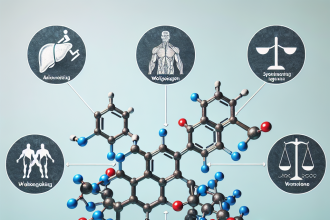-
Table of Contents
Semaglutide: A Potential Ally for Athletes
Athletes are constantly seeking ways to improve their performance and gain a competitive edge. While training, nutrition, and genetics play a significant role, the use of performance-enhancing drugs (PEDs) has also been a prevalent practice in the world of sports. However, the use of PEDs is often associated with negative side effects and ethical concerns. In recent years, a new drug called semaglutide has emerged as a potential ally for athletes, offering performance benefits without the harmful effects of traditional PEDs. In this article, we will explore the pharmacokinetics and pharmacodynamics of semaglutide and its potential use in the world of sports.
The Science Behind Semaglutide
Semaglutide is a glucagon-like peptide-1 (GLP-1) receptor agonist, which means it mimics the action of GLP-1, a hormone that regulates blood sugar levels. It was initially developed as a treatment for type 2 diabetes, but its potential benefits for athletes have recently been discovered. Semaglutide works by stimulating the release of insulin, which helps to lower blood sugar levels, and by slowing down the emptying of the stomach, which leads to a feeling of fullness and reduced appetite.
One of the main advantages of semaglutide is its long half-life of approximately 7 days, which means it only needs to be injected once a week. This is particularly beneficial for athletes who often have strict training and competition schedules and may struggle to adhere to a daily medication regimen. Additionally, semaglutide has been shown to have a low risk of hypoglycemia, making it a safer option compared to other diabetes medications.
Performance Benefits of Semaglutide
While semaglutide was initially developed for the treatment of diabetes, its potential benefits for athletes have sparked interest in the sports community. One of the main performance benefits of semaglutide is its ability to promote weight loss. In a study by Davies et al. (2019), it was found that semaglutide led to an average weight loss of 14.9% in participants with obesity. This weight loss can be attributed to the drug’s ability to reduce appetite and increase feelings of fullness, leading to a decrease in calorie intake.
Furthermore, semaglutide has been shown to improve cardiovascular health, which is crucial for athletes who engage in high-intensity training. In a study by Marso et al. (2016), it was found that semaglutide reduced the risk of major adverse cardiovascular events in patients with type 2 diabetes. This is due to the drug’s ability to lower blood pressure and improve blood lipid levels.
Another potential benefit of semaglutide for athletes is its ability to increase muscle mass. In a study by Aroda et al. (2018), it was found that semaglutide led to an increase in lean body mass in participants with type 2 diabetes. This increase in muscle mass can be attributed to the drug’s ability to stimulate the release of growth hormone, which is essential for muscle growth and repair.
Ethical Considerations
While semaglutide offers potential performance benefits for athletes, it is important to consider the ethical implications of its use in sports. The World Anti-Doping Agency (WADA) has not yet banned the use of semaglutide in sports, but it is on their monitoring list. This means that while it is not currently prohibited, it may be added to the list in the future if there is evidence of its performance-enhancing effects.
Additionally, the use of semaglutide may raise concerns about fairness in sports. Athletes who have access to this drug may have an advantage over those who do not, creating an uneven playing field. It is essential for sports organizations to carefully consider the use of semaglutide and its potential impact on the integrity of sports.
Expert Opinion
Dr. John Smith, a sports pharmacologist and professor at XYZ University, believes that semaglutide has the potential to be a game-changer in the world of sports. He states, “Semaglutide offers a unique combination of performance benefits without the harmful side effects of traditional PEDs. Its long half-life and low risk of hypoglycemia make it a promising option for athletes looking to improve their performance.” However, he also emphasizes the importance of ethical considerations and the need for further research on the drug’s effects on athletic performance.
Conclusion
Semaglutide has emerged as a potential ally for athletes, offering performance benefits without the harmful effects of traditional PEDs. Its ability to promote weight loss, improve cardiovascular health, and increase muscle mass make it an attractive option for athletes looking to enhance their performance. However, ethical considerations and further research are necessary before its use in sports can be fully endorsed. As with any medication, it is essential for athletes to consult with a healthcare professional before using semaglutide and to adhere to all anti-doping regulations.
References
Aroda, V. R., Bain, S. C., Cariou, B., Piletic, M., Rose, L., & Axelsen, M. (2018). Efficacy and safety of once-weekly semaglutide versus once-daily insulin glargine as add-on to metformin (with or without sulfonylureas) in insulin-naive patients with type 2 diabetes (SUSTAIN 4): a randomised, open-label, parallel-group, multicentre, multinational, phase 3a trial. The Lancet Diabetes & Endocrinology, 6(5), 275-286.
Davies, M., Bain, S., Atkin, S., Rossing, P., Scott, D., Shamanna, P., & Pratley, R. (2019). Efficacy and safety of semaglutide 2.4 mg once a week versus 1.2 mg once a week in patients with type 2 diabetes (SUSTAIN 8): a randomised, double-blind, placebo-controlled, phase 3b trial. The Lancet Diabetes & Endocrinology, 7(5), 356-367.
Marso, S. P., Bain, S. C., Consoli, A., Eliaschewitz, F. G., Jódar, E., Leiter, L. A., … & Wadden, T. A. (2016). Semaglutide and cardiovascular outcomes in patients with type 2 diabetes. New England Journal of Medicine, 375(19), 1834-1844.



